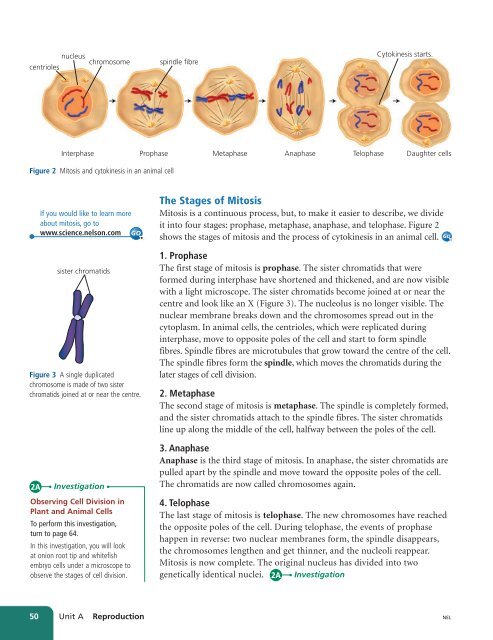Unit A Reproduction
Unit A Reproduction
Unit A Reproduction
Create successful ePaper yourself
Turn your PDF publications into a flip-book with our unique Google optimized e-Paper software.
centrioles<br />
nucleus chromosome<br />
spindle fibre<br />
DNA<br />
Cytokinesis starts.<br />
nucleus<br />
Interphase Prophase Metaphase Anaphase Telophase<br />
Daughter cells<br />
Figure 2 Mitosis and cytokinesis in an animal cell<br />
sister chromatids<br />
Figure 3 A single duplicated<br />
chromosome is made of two sister<br />
chromatids joined at or near the centre.<br />
2A<br />
If you would like to learn more<br />
about mitosis, go to<br />
www.science.nelson.com GO<br />
Investigation<br />
Observing Cell Division in<br />
Plant and Animal Cells<br />
To perform this investigation,<br />
turn to page 64.<br />
In this investigation, you will look<br />
at onion root tip and whitefish<br />
embryo cells under a microscope to<br />
observe the stages of cell division.<br />
The Stages of Mitosis<br />
Mitosis is a continuous process, but, to make it easier to describe, we divide<br />
it into four stages: prophase, metaphase, anaphase, and telophase. Figure 2<br />
shows the stages of mitosis and the process of cytokinesis in an animal cell.<br />
1. Prophase<br />
The first stage of mitosis is prophase. The sister chromatids that were<br />
formed during interphase have shortened and thickened, and are now visible<br />
with a light microscope. The sister chromatids become joined at or near the<br />
centre and look like an X (Figure 3). The nucleolus is no longer visible. The<br />
nuclear membrane breaks down and the chromosomes spread out in the<br />
cytoplasm. In animal cells, the centrioles, which were replicated during<br />
interphase, move to opposite poles of the cell and start to form spindle<br />
fibres. Spindle fibres are microtubules that grow toward the centre of the cell.<br />
The spindle fibres form the spindle, which moves the chromatids during the<br />
later stages of cell division.<br />
2. Metaphase<br />
The second stage of mitosis is metaphase. The spindle is completely formed,<br />
and the sister chromatids attach to the spindle fibres. The sister chromatids<br />
line up along the middle of the cell, halfway between the poles of the cell.<br />
3. Anaphase<br />
Anaphase is the third stage of mitosis. In anaphase, the sister chromatids are<br />
pulled apart by the spindle and move toward the opposite poles of the cell.<br />
The chromatids are now called chromosomes again.<br />
4. Telophase<br />
The last stage of mitosis is telophase. The new chromosomes have reached<br />
the opposite poles of the cell. During telophase, the events of prophase<br />
happen in reverse: two nuclear membranes form, the spindle disappears,<br />
the chromosomes lengthen and get thinner, and the nucleoli reappear.<br />
Mitosis is now complete. The original nucleus has divided into two<br />
genetically identical nuclei. 2A Investigation<br />
GO<br />
50 <strong>Unit</strong> A <strong>Reproduction</strong><br />
NEL

















